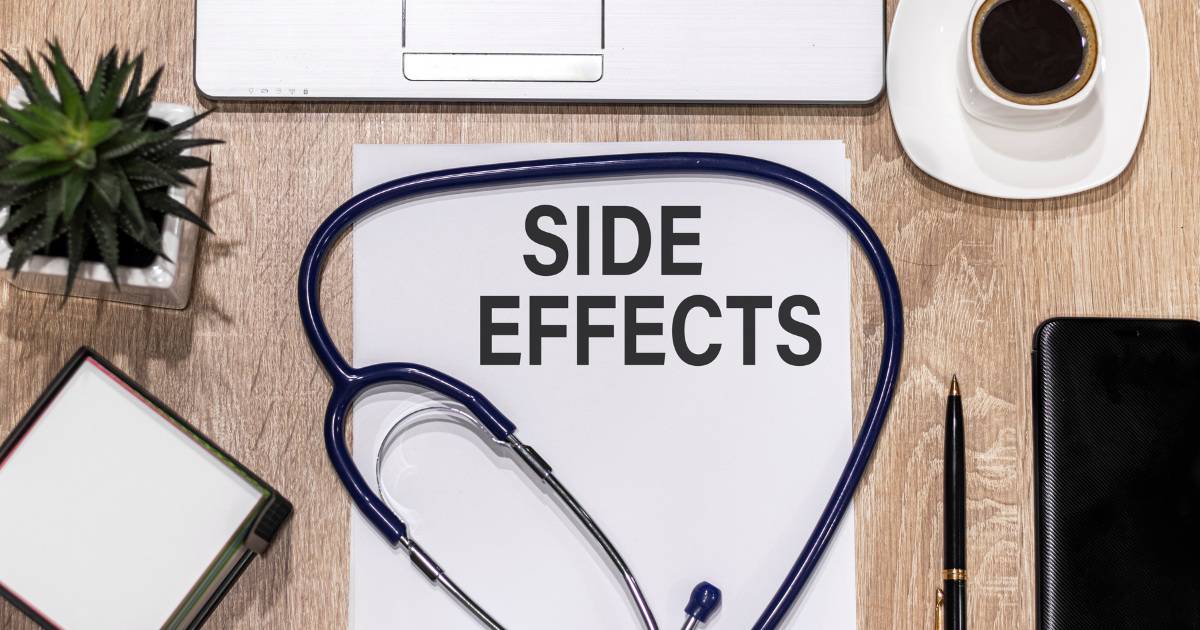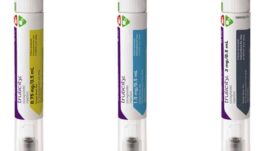Trulicity is a once-weekly injectable medication designed for adults with type 2 diabetes, approved to help manage blood sugar levels more effectively.
It not only helps with managing diabetes but also supports weight loss and helps prevent stroke, heart attacks, and premature death in those with preexisting heart conditions.
But it does have potential side effects.

Key Facts
- Trulicity is a weekly injectable medication for people with type 2 diabetes.
- It’s not a substitute for insulin but is often used alongside it to improve blood sugar control and support weight loss.
- Common side effects include nausea, vomiting, stomach pain, and potential injection site reactions like redness and swelling. These effects are generally mild to moderate.
- Rare but significant side effects include acute pancreatitis, severe allergic reactions, and potential thyroid cancer risks.
- Trulicity is suitable for adults with type 2 diabetes and certain heart conditions, but not recommended for those with severe gastroparesis or chronic kidney disease.
- Alternatives like Ozempic and Victoza may be considered for those experiencing severe side effects.
Table of Contents
- How does Trulicity work?
- What are the potential side effects?
- How long do side effects last?
- How can you mitigate the side effects?
- Does taking more Trulicity make the side effects worse?
- Do you have to take Trulicity with food?
- How do I know if I should stop taking Trulicity?
- Who should not use Trulicity?
- Are there alternatives to Trulicity?
How does Trulicity work?
Trulicity, a medication containing the active ingredient dulaglutide, is not a form of insulin nor does it replace insulin. However, it is frequently used alongside insulin to improve diabetes management.
The medication works by attaching to specific receptors on pancreatic cells, prompting the release of more insulin, which helps lower blood sugar levels.
Additionally, Trulicity reduces glucagon production in the liver, preventing spikes in blood sugar after meals and enhancing insulin sensitivity. It also slows digestion, which suppresses appetite and can lead to weight loss over time.
Learn more in: Everything You Need to Know About Trulicity.
What are the potential side effects?
Trulicity may cause a range of side effects, typically minor to moderate, which are normal especially when beginning treatment.
Common side effects include:
- Suppressed appetite
- Weight loss
- Nausea
- Vomiting
- Stomach pain
- Redness, swelling, and bruising at the injection site
- Fatigue
- Diarrhea
- Low blood sugar (especially if you also use insulin)
A few rare but serious and/or long-term side effects have been noted, including:
- Acute pancreatitis
- Severe allergic reaction
- Diabetic retinopathy (the medicine can worsen diabetic retinopathy if you already have the condition)
- Gallbladder disease
- Impaired kidney function
- Medullary thyroid carcinoma (MTC, a type of thyroid cancer)
The FDA has also issued a black box warning linking Trulicity to an increased risk of thyroid cancer.
People with conditions like gastroparesis or chronic kidney disease (CKD) should consult their doctor before using Trulicity, as it may worsen these conditions.
If side effects last for more than a few weeks or become debilitating, affecting work, school, or social life, discuss with your doctor the possibility of adjusting the dosage or switching to an alternative medication.
How long do side effects last?
Nausea is the most commonly reported side effect, affecting 8 to 29 percent of users, according to the manufacturer. While this side effect generally resolves within the first two weeks for most people, it can last longer in some cases.
Additionally, fewer than 2 percent of users find it necessary to discontinue Trulicity due to nausea.
It’s important to note that other side effects such as diarrhea, vomiting, and decreased appetite may also occur, but these typically decrease as the body adjusts to the medication over a similar timeframe. If side effects persist or worsen, consult your healthcare provider.
How can you mitigate the side effects?
Managing the side effects of Trulicity involves several strategies to maintain comfort and safety. If you experience nausea, vomiting, or diarrhea, it’s important to stay hydrated. Drinking plenty of water and consuming electrolytes, such as those found in coconut water, can help.
Monitoring your blood sugar levels is also essential; if they are consistently too high, you may be at risk for diabetic ketoacidosis (DKA), a potentially life-threatening condition.
Similarly, low blood sugar can be dangerous, especially if you are also taking insulin, and requires careful management.
To reduce nausea, eat bland foods like toast, rice, bananas, and applesauce, and ensure you drink clear liquids. If nausea prevents you from keeping food or drink down, seek medical attention immediately.
Eating smaller, more frequent meals can help manage gastrointestinal symptoms. Stop eating when you are full, even if the amount seems less than usual.
For persistent nausea, consider over-the-counter remedies like Dramamine (dimenhydrinate), or discuss prescription options like Zofran (ondansetron) with your doctor.
Does taking more Trulicity make the side effects worse?
Increasing the dose of Trulicity can indeed raise the likelihood of experiencing side effects.
Clinical studies reveal that higher doses result in increased side effects. For instance, about 16 percent of participants in one study reported worsened nausea, leading approximately 1 percent to discontinue the medication.
Therefore, it is important to stick strictly to your doctor’s prescribed dosage of Trulicity, particularly when starting the medication. Your doctor will carefully adjust your dose based on how your body responds, ensuring the best balance between effectiveness and tolerability.
See more in: Trulicity Dosing: How Much Should You Take?
Do you have to take Trulicity with food?
No, Trulicity does not require food when taken, which differs from many insulin treatments.
It gradually lowers blood sugar levels without causing the acute lows that can occur with insulin. Consistency in taking your dose is crucial, so it’s best to take the medicine at a time that’s easy for you to remember.
However, if you experience nausea after taking your dose, eating a small amount of food beforehand might help reduce this discomfort, although it’s not necessary.
Read more in: Food to Avoid When Taking Trulicity.
How do I know if I should stop taking Trulicity?
If Trulicity’s side effects become debilitating and disrupt your daily life, discuss this with your doctor. Should you both decide to stop the treatment, your doctor will likely taper your dose gradually over several weeks, rather than discontinuing it abruptly.
Patience is important if you’re considering stopping due to a lack of immediate improvements in blood sugar levels or weight loss. It’s common for these changes to take time with any medication, including Trulicity.
Typically, doctors recommend allowing several months for the medication to achieve its full effect before deciding to discontinue it.
Who should not use Trulicity?
Trulicity is not suitable for everyone. People allergic to dulaglutide, the active ingredient in Trulicity, should avoid it. It is also contraindicated for those with a personal or family history of medullary thyroid carcinoma (MTC) or multiple endocrine neoplasia.
Additionally, Trulicity is not approved for children under 18 years old unless prescribed by a physician. It is not recommended for individuals who are pregnant, planning to become pregnant, or breastfeeding.
If you have chronic kidney disease (CKD) or gastroparesis, speak with your doctor before using Trulicity, as it may worsen these conditions. Also, Trulicity is not designed to treat prediabetes or type 1 diabetes.
Are there alternatives to Trulicity?
If you’re experiencing negative side effects with Trulicity, it’s important to consult your doctor about possible alternative medications that might be better tolerated. Some potential alternatives to Trulicity include:
- Ozempic (semaglutide) and Ryebelsus (semaglutide): Both contain the same active ingredient but are administered differently.
- Mounjaro (tirzepatide) and Victoza (liraglutide): These medications also aim to improve blood sugar management in type 2 diabetes.
- Farxiga (dapagliflozin), Jardiance (empagliflozin), and metformin: These offer additional mechanisms of action and may be suitable depending on your health profile and specific needs.
Did you find this article helpful? Click Yes or No below to let us know!





